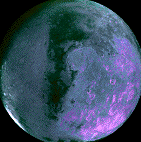 Inse
Inse Inse
Inse| Bearing from Terra (relative to Core) (degrees): |
|
| Distance from Terra: | 22.4 kpsc |
| Other location data: | On the outskirts of the Galaxy, 2.7 kiloparsecs from Borshall and 3.5 kiloparsecs from New Sardinia |
| Total Irradiation | (Terra = 1): | mean: 0.2 max: 0.307 min: 0.140 |
| Distance from Star | (A.U): | mean: 0.671 max: 0.8006 min: 0.5416 |
| (million km): | mean: 100.355 max: 119.777 min: 81.023 | |
| Revolution | (Terran years): | 8.791 |
| (Terran days): | 3,210.934 | |
| (Local days): | 893.996 | |
| Diameter | (Terra = 1): | 1.068 |
| (km): | 13,623 | |
| Mass | (Terra = 1): | 1.0408 |
| Density | (g/cc): | 4.699 |
| (Terra = 1): | 0.854 | |
| Surface Gravity | (Terra = 1): | 0.8 |
| Length of Day | (hours): | 86.2 |
| Orbital Inclination | (degrees): | 14 |
| Moons | 0 | |
| Other | orbital eccentricity: 0.193 axial tilt: 34 degrees sea-level air pressure: 3000 (3.0 Terra) Mean temperature hi/low: Summer: 7º/-8 º Winter: -32 º/-52 º |
Inse was probably a moon of Eaun or Posle, knocked into a smaller, eccentric orbit by early catastropic event.
| Primary: | Tau Cedri |
| Spectral Class: | M |
| Mass: | 0.25 Sol |
| Luminosity: | 0.09 Sol |
| Planet | Name | Mass (Terra = 1) | Distance | Diameter | General |
| 1 | Inse | 1.04 | 100.4 million km | 13,623 km | eccentric orbit |
| 2 | Eaun | 477 | 233.4 million km | 17.9 terra | Jovian |
| 3 | Posle | 273 | 335.1 million km | 16.4 terra | Jovian |
| 4 | Nacir | 375 | 535.6 million km | 17.9 terra | Jovian |
| 5 | Karn | 0.848 | 936.5 million km | 1.2 terra | Rocky |
| 6 | -- | 11 | 11.627 AU | 4.3 terra | Methane Giant |
| 7 | -- | 1.9 | 22.4 AU | 1.6 terra | Rocky |
| 8 | -- | 0.41 | 43.8 AU | 1.12 terra | Rocky |
| 9 | -- | 24 | 86.8 AU | 6.1 terra | Methane Giant |
| Founded: | TE 315 |
| Social Characteristics: | |
| Population: |
Overview:
Inse is Terra-size world on the outskirts of the Galaxy, 2.7 kiloparsecs from Borshall and 3.5 kiloparsecs from New Sardinia, settled TE 315 (2468 CE) as a mining base.
Inse is a very cold world. Its primary, Tau Cedri, is an M-type red dwarf. Although Inse averages about 0.67 AU from Tau Cedri, it receives about 20% of the heat and light that Earth receives. Luckily, the atmosphere is three times as dense as Earth's and contains a larger amount of carbon dioxide; without the greenhouse effect, temperatures on Inse would hover around -70 º celsius. Even with the greenhouse effect and in temperate zones, daytime temperatures rarely go above 5 º in the summer, and a chilly 35 º below in winter.
Inse is geologically active; some valleys warmed by geothermal processes are actually livable for Humans (summer temperatures sometimes hit 25 º, and winter daytime temperatures are just above freezing.)
The planet is the first of nine, in a system that contains three major Jovian gas giants -- its orbit is eccentric and hjighly inclined to the ssytem ecliptic, and Imperial Galactographic Survey scientists quickly decided that Inse was once a moon of one of the gas giants, knocked into its present orbit in some kind of catastrophe only one or two billion years ago.
Due to the presence of the gas giants and the abundance of geological activity, Inse was an important mining site in Middle Empire times, and remained under the control of Borshall Province throughout the Patalanian War. During this time, the population never exceeded a hundred thousand.
After the Fall of the Empire, Inse maintained a precarious existence trading with Borshall, New Sardinia, and Terexta; however, it was never a highly important port, and did not (for example) become part of the Tr#skan Trade Union. With the formation of the Sardinian Leage in 5973 CE, Inse attracted limited interest from the Metrinal Union, and her folk began slowly to move away to both Sardinian and Metrinal worlds. By 6800 CE, the population had declined to about 1500, all concentrated in one valley. The disastrous winter of 6916-8 CE destroyed crops and completely buried the last remaining deep-mining installation under a massive avalanche. Hundreds left right away and in early 6918 CE the last Human settlers departed Inse.
Although there were rumors of sporadic expeditions, Inse was not repopulated until Metrinal Union refugees landed there in 8259 CE. About 8600 CE, Inse became a trading partner of the Borshallan Federation, and a terraforming project was undertaken with the co-operation of the native Hlutr.